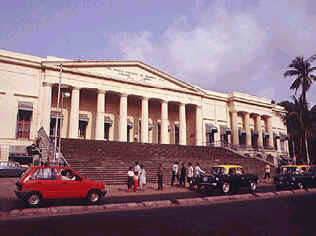| ASIATIC SOCIETY LIBRARY |

____________________________________________________ |
|
The town hall which houses the Asiatic Library with its
old parquet floor, spiral staircases and wrought iron loggias is perhaps
the most elegant heritage building in Mumbai. It has a collection of 800,000
antique volumes, and ancient coins. This pleasantly neo-classical building
now houses the library of the Asiatic Society, as well as a small museum.
The museum contains statues of some 19th century governors of Bombay, some
British scholars and administrators and two Indian philanthropists and
an Indian scholar.
In 1811, James McKintosh, then Recorder of Bombay and resident of the Literary Society of Bombay, revived an earlier suggestion of a Town Hall for the city. The society intended that this building should house not only the civic offices, but also a library and a museum along with civic offices. The Literary Society raised a fund of Rs. 10,000 through a lottery, but when this turned out to be insufficient, the government had to be persuaded to bear the costs of construction; a process that took ten years. The building is 200 feet long and 100 feet deep. The facade has three porticoes faced by Ionic columns. The plans called for a double row of columns, built out of material brought from England. Although these plans were curtailed, the final cost of the building came to about 500,000 pounds; far in excess of the initial estimates. The East India Company took on a major part of the expense. The building was completed in 1833, after the death of Cowper. With its old parquet floors, spiral staircases, wrought iron loggias, and exquisite marble statues of forgotten city fathers, the colonnaded Town Hall is perhaps the most regal and elegant of Mumbai's heritage buildings. One of them is a priceless first edition copy of Dante's "Inferno." There is also an impressive numismatic collection of over 1,000 ancient coins and a rare gold mohur belonging to the Mughal Emperor Akbar. One needs permission to look at these treasures, but the public library is open to all and usually draws a large number of senior citizens who pore over the local newspapers in the fading grandeur of its reading room. Functions of the society
|